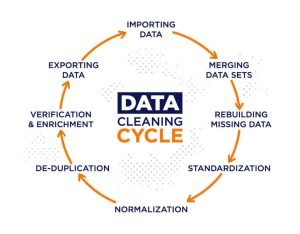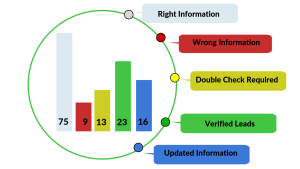Why did that promising deal stall? Why are my top reps spinning their wheels on dead-end leads? Why is our sales forecast so wildly inaccurate, quarter after quarter?
If you’re a sales leader, these questions are likely keeping you up at night. You’ve invested in the best talent, a top-tier CRM, and endless sales training. Yet, you’re still fighting for every percentage point of growth. The culprit might not be your people or your process, but something far more insidious hiding in plain sight: dirty data.
Bad data is the silent killer of sales productivity and the anchor dragging down your revenue potential. But the flip side is a powerful truth: investing in data cleanliness isn’t just an IT chore; it’s one of the highest ROI activities your sales organization can undertake.
Let’s move beyond anecdotes and dive into the hard data that proves why a clean database is your most valuable asset.
The Staggering Cost of “A Few Bad Records”
We often underestimate the scale of the dirty data problem. A wrong phone number here, an outdated job title there—it seems minor. But when multiplied across thousands of records, the financial impact is devastating.
- The Trillion-Dollar Problem: IBM estimates that the cost of poor-quality data to the U.S. economy is a staggering $3.1 trillion per year.
- The Company-Level Impact: On a more relatable scale, Gartner’s research found that the average financial impact of poor data quality on an organization is $12.9 million annually. For many businesses, that’s the difference between a record-breaking year and missing targets completely.
- The Silent Decay: Data doesn’t just start dirty; it gets dirty over time. According to research from SiriusDecisions, a staggering 25-30% of B2B contact data becomes obsolete every single year. People change jobs, companies get acquired, phone numbers are disconnected. Without a proactive strategy, your CRM is actively rotting from the inside out.
Dirty data isn’t just a line item in a report; it’s a direct tax on your sales team’s time, morale, and effectiveness.

How Clean Data Directly Translates to More Revenue
Connecting the dots between a clean CRM and a fatter bottom line is surprisingly direct. Here are the four key ways data hygiene drives sales performance.
1. Hyper-Personalization that Actually Works
In today’s market, generic outreach is a one-way ticket to the spam folder. Personalization is king, but it’s impossible without accurate data.
Clean data means knowing your prospect’s correct name, title, company, industry, and recent activity. It allows your reps to move beyond “Hi [First_Name]” and craft messages that resonate.
- The Data-Driven Proof: A McKinsey report revealed that fast-growing companies drive 40% more of their revenue from personalization than their slower-growing counterparts. This level of personalization is only possible with a foundation of clean, reliable, and enriched data.
- Dirty Data Scenario: An email is sent to a VP of Marketing who left the company six months ago. The email bounces, wasting the rep’s time and damaging your domain’s sending reputation.
- Clean Data Scenario: Your system, enriched with up-to-date information, flags the job change. The rep now has a new lead at the old company and a warm introduction to a new contact at the prospect’s new company—two opportunities from one data point.
2. Skyrocketing Sales Productivity and Morale
What’s the #1 complaint from sales reps? Wasting time on non-selling activities. A huge portion of that wasted time is spent wrestling with bad data.
- The Productivity Drain: Research from Salesforce shows that sales reps spend, on average, only 28% of their week actually selling. The rest is consumed by administrative tasks, including manually correcting bad data, researching missing information, and dealing with bounced emails and wrong numbers.
Imagine giving nearly three-quarters of your team’s time back to them. By providing clean, enriched data, you eliminate the soul-crushing detective work. Reps can trust the information in the CRM, allowing them to do what they do best: build relationships and close deals. This not only boosts productivity but also drastically improves job satisfaction and reduces costly team churn.
3. Forecasting You Can Actually Trust
For VPs of Sales and CROs, accurate forecasting is non-negotiable. It dictates hiring plans, budgets, and investor confidence. But a forecast built on a dirty pipeline is a house of cards.
Dirty data creates duplicate opportunities, miscategorizes deal sizes, and inflates your pipeline with dead or zombie leads. You’re making strategic, multi-million dollar decisions based on fiction.
- The Data-Driven Proof: A survey by LeanData found that 72% of sales and marketing leaders believe that unclean data is the biggest hindrance to effective sales and marketing alignment and strategy.
With clean data, you can:
- Reliably segment your pipeline by industry, region, or company size.
- Accurately identify your Ideal Customer Profile (ICP) based on real win/loss data.
- Trust your pipeline coverage ratios and make confident strategic bets.
4. Higher Lead Conversion & Shorter Sales Cycles
This is where it all comes together. Clean data fuels a more efficient sales process from top to bottom.
- Lead Scoring & Routing: Accurate data allows your marketing automation and lead scoring models to work properly. High-quality leads are identified faster and routed to the right rep instantly. This speed is critical—a study by LeadResponseManagement.org showed that a lead is 100x more likely to be qualified if contacted within 5 minutes.
- Fewer Dead Ends: Reps focus their energy on validated, qualified leads, dramatically increasing their conversion rate from contact to opportunity.
- Informed Conversations: With a full history of a contact’s interactions, past purchases, and support tickets, reps can have more relevant and valuable conversations, shortening the path to a close.
The 5-Step Blueprint for Data Purity
Ready to turn your data into a revenue-generating machine? It’s not an overnight fix, but a strategic process.
- Conduct a Data Audit: You can’t fix what you can’t measure. Use a data quality tool or a manual sampling to understand the health of your database. What percentage of records are incomplete, duplicates, or outdated?
- Establish a Single Source of Truth (SSoT): Your CRM must be the undisputed champion of data. All other tools (marketing automation, sales enablement, customer support) must integrate and sync with the SSoT, not create competing data silos.
- Automate Cleansing & Enrichment: Manual cleaning is not scalable. Invest in data automation tools (like ZoomInfo, Clearbit, or built-in CRM features) that can deduplicate, validate, and enrich your records in real-time.
- Implement Strict Data Governance: Create clear, simple rules for data entry. Use required fields, standardized picklists (e.g., for states, countries, job titles), and define who is responsible for data quality.
- Foster a Data-Driven Culture: This isn’t just an ops problem; it’s everyone’s responsibility. Train your sales team on why data hygiene matters. Tie a small part of their incentives or recognition to maintaining clean records in the CRM.

The Final Word
Viewing data cleaning as a “cost center” is an outdated and dangerous mindset. The evidence is overwhelming: CRM Data Cleanup Services is a revenue-generating asset.
By eliminating the drag of dirty data, you empower your team to be more productive, personalize their outreach, and focus on the opportunities most likely to close. You transform your forecasting from guesswork into a science.
Don’t let bad data be the secret holding back your sales performance. The path to more revenue is paved with clean, accurate, and actionable information. Start your cleanup today with Leadavail.
